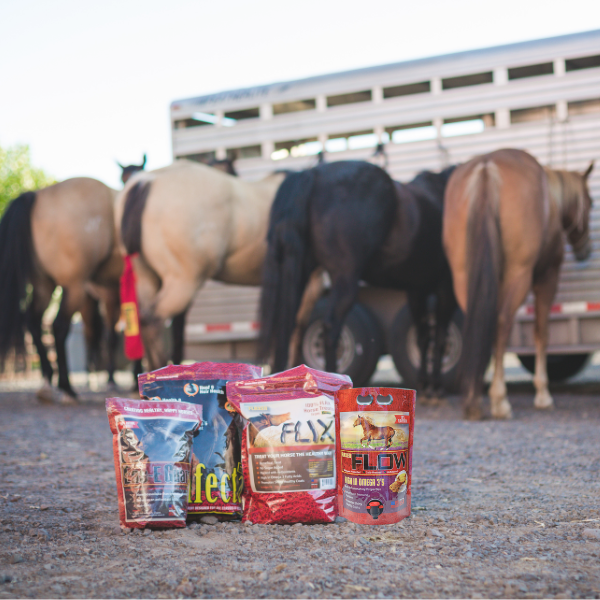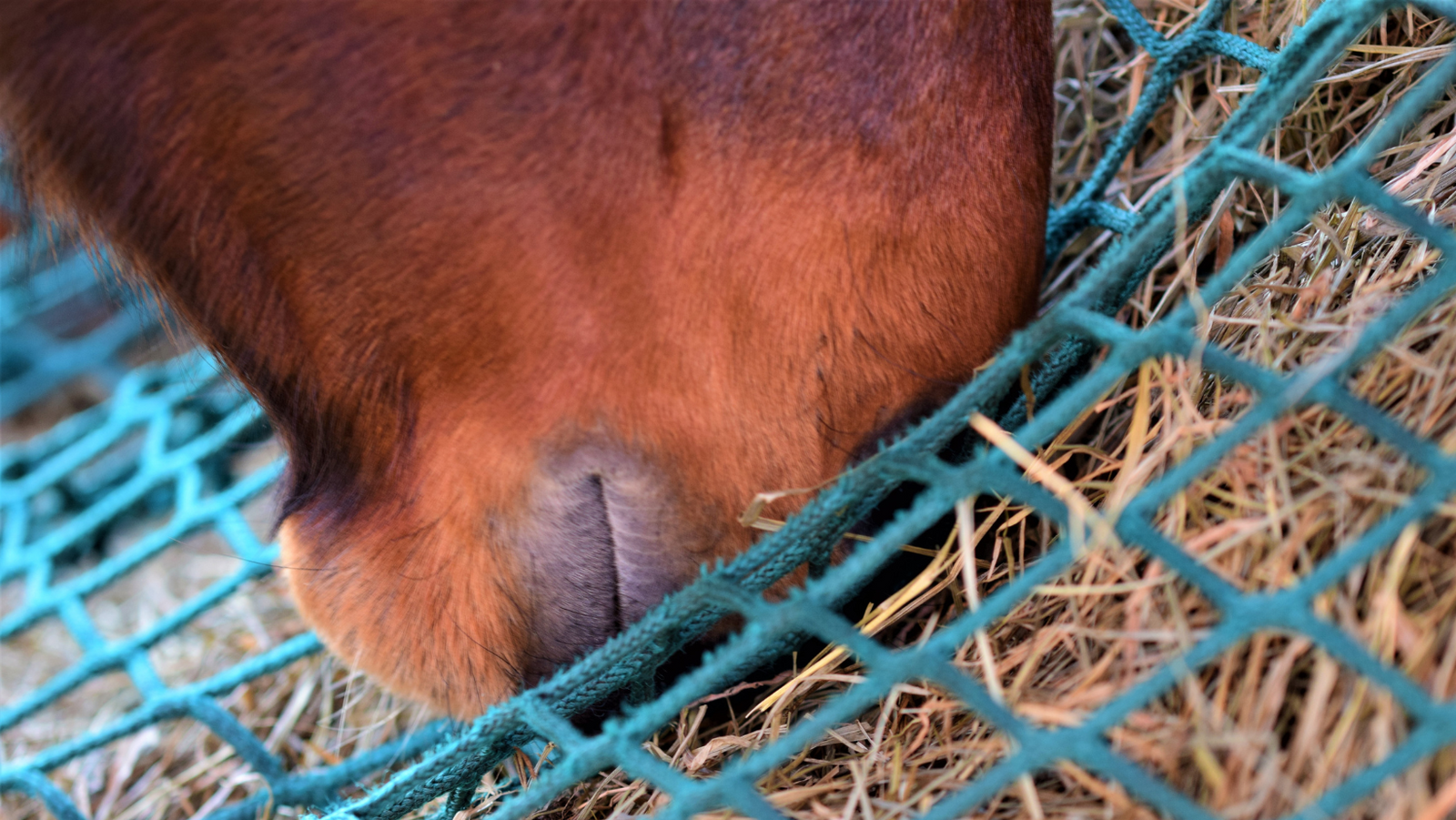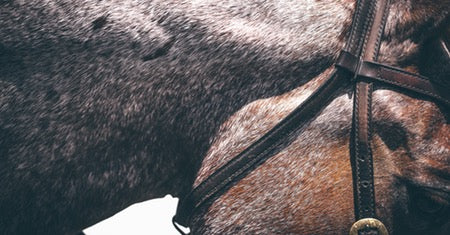Horses Evolved for Continuous Foraging
Horses have evolved to graze continually throughout the day. With a stomach that only makes up 9% of the horse’s total digestive tract and only holds about 3-5 gallons in an 1,100-pound horse, they have the smallest stomach in relation to body size of all domestic animals.
In addition, unlike humans, their stomach continually secretes gastric juices at a rate of about 1.5 liters an hour, even when the horse is fasting. Thus, providing them with forage constantly throughout the day can help to reduce ailments such as gastric ulcers or colic and help reduce the chance of horses developing bad habits such as coprophagy (eating their own manure). But how do we get them to keep from gaining too much weight and becoming obese?
Hay Consumption with Slow Feed Hay Nets
An ongoing study at the University of Wisconsin-River Falls has shown that hay nets can be a great solution to allowing your horse access to feed all the time while maintaining the health of your horse and reducing waste. Horses that were fed using the hay nets consumed, on average 2.6% of their body weight, whereas the horses with no hay net consumed, on average 3.3% of their body weight.

After one year of the assigned feeding practices, there was no difference in the soft tissue of tooth wear between the horses using a hay net or no hay net. However, horses fed in hay nets had lower body
weights, body condition scores, and hay usage than the horses consuming hay without the hay nets. The yearlong study showed that using a hay net saved $227 per horse annually. (Johnson, et al., 2023)
Increased Feeding Time Offers A Decrease In Stress
At Colorado State University, they compared feeding horses using free-choice hay, slow feeders, and box feeders that opened periodically throughout the day. Horses that had access to free-choice hay and slow feeders foraged for more than double the amount of time as compared to the horses fed in box feeders.
As a result, horses fed with box feeders had more time standing attentively, sniffing the ground, and practicing coprophagy. Horses fed with a box feeder also had a higher level of aggression.
Horses fed free-choice hay or slow feeders foraged for about the same amount of time that horses would naturally graze when turned out. They also found that horses fed free-choice or using slow feeders laid down more than horses fed with box feeders, implying that they were more comfortable and relaxed.
Horses on free-choice hay consumed and wasted more hay than horses fed using slow feeders. The horses on free-choice hay gained much more weight than horses on slow feeders or box feeders. Even more interesting, the horses fed with slow feeders consumed less hay and gained less weight than the horses fed with box feeders. (Seabra, et al., 2023)
How Does The HG Herd Eat?
I personally have twenty head of horses and feed them all in slow feeder hay nets. In my personal observations, I have noticed that when a new horse is brought onto the place that was originally getting fed two meals a day, in the first two months that horse will consume nearly double than that of our other horses consume that have been fed through slow feeder hay nets for years. After about two months that horse’s consumption drastically reduces.
I believe relates directly to Seabra et al. study that showed that horses with box feeders consumed more than horses on slow feeders. It supports the theory that when horses are limit-fed they gore themselves, worried about being hungry until their next meal. Whereas when they have access to feed all the time, they revert back to their more natural grazing pattern.
Where Does the Rest of the Diet Come Into Play?
Feeding ad-libitum hay through slow feeder hay nets along with a vitamin-mineral supplement to meet common deficiencies allows most horses to thrive. Horse Guard, Trifecta, Mega Dose, and Super Weight Gain provide that vitamin-mineral package to help ensure all their needs are being met. In reality most horses, unless under strenuous workout plans or horses that need to gain weight, don’t need to be fed grains.
Use Hay Nets As Directed
It is important to note that it is important that you use the slow feeder hay net in a safe manner. Follow instructions of hay net companies on how to best use the hay net. I personally put the big bale slow feeder hay nets in metal feeders designed for horses, so they can’t paw the netting and get their shoes stuck. For my individual slow feeder hay nets, I mount them on the fence above the ground, so they aren’t as easily pawed.
Save Money, Lower Waste, and Keep Your Horse Happy & Healthy
The evidence shows that using hay nets is a great way to help reduce waste and maintain a healthy weight for horses. By feeding out of a slow feeder hay net you mimic the conditions they are would be in more naturally grazing different terrains.
The horse must work harder to consume its feed while allowing them to always keep something in their stomach to buffer the always secreting acid. This can help to maintain an ideal Body Condition Score.
In addition, by using hay nets, horses are not able to waste as much hay by trampling on it or soiling it with their urine and manure. This can lead to significant savings in hay costs over time.
Johnson, L., Martinson, K., Keener, L., & DeBoer, M. (2023). 64 A preliminary study: Effect of hay nets on horse hay usage, dental wear, and dental conditions in mature adult horses. Journal of Equine Veterinary Science, 124, 104366.
Seabra, J. C., Hess, T., do Vale, M. M., Spercoski, K. M., Brooks, R., & Dittrich, J. R. (2023). 49 Effects of different hay feeders, availability of roughage on abnormal behaviors and time budget of horses kept in dry lots. Journal of Equine Veterinary Science, 124, 104351.






Leave a comment (all fields required)